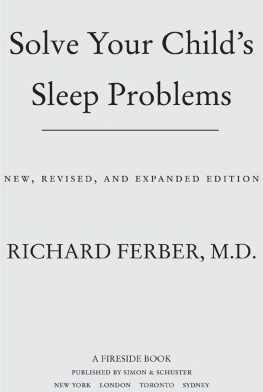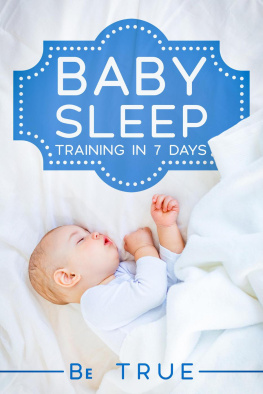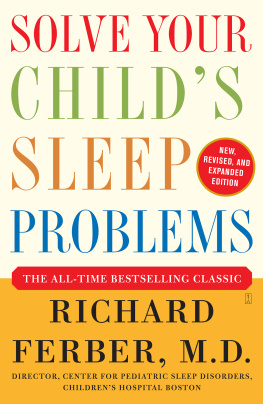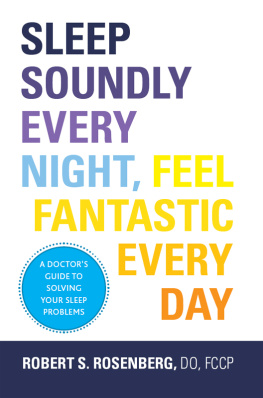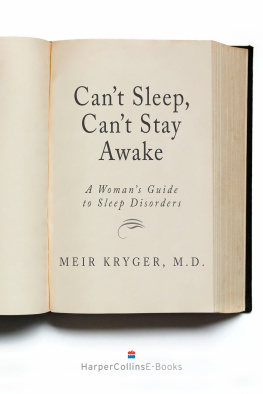Copyright 1985, 2006 by Richard Ferber, M.D.
in whole or in part in any form.
FIRESIDE and colophon are registered trademarks of Simon & Schuster, Inc.
Ferber, Richard.
Solve your childs sleep problems / Richard Ferber.Completely rev. and updated ed.
p. cm.
Includes index.
1. Sleep disorders in children. I. Title.
To my sons, Matthias and Thaddeus.
As children, they taught me how to be a parent.
As adults, they have taught me to remember being a child.
Preface to the Second Edition
When the first edition of this book appeared in 1985, the medical field devoted to the treatment of sleep disorders in children was new. Still, over the years, the basic information I presented on the nature of sleep and sleep problems in children has remained sound, and the techniques I described to help children with sleep problems have proven to be well conceived and practical. The value of these approaches has been confirmed repeatedly, not only at our sleep disorders center in Boston but at many othersand by many different professionalsaround the world. Most of the comments I have received from families who carefully read and then applied the techniques outlined in the first edition have expressed gratitude, with parents thanking me for helping them find a solution to a sleep problem that had been going on for months or years.
So why did I see the need, twenty years later, for this revised and considerably expanded edition? There are three main reasons.
The first reason is to correct some widespread misconceptions regarding my methods and their application. My goals have always been to help parents understand the nature of sleep and of childhood sleep problems, determine the causes of their own childs sleep difficulties, and choose or design an appropriate treatment program that fits their own philosophy of child rearing. I have always believed that the more you understand about your childs sleep problems, the more humane and effective you can be in solving them. A child may cry repeatedly each night, for example, but until parents understand why that is happening and institute proper treatment, they may be unable to resolve it in a way they find satisfactory.
Despite my efforts in the first edition to communicate these goals, it became clear that they were not always understood as I had intended. Many people thought I recommended a single method to treat all sleep problems, regardless of the nature of the problems, their causes, or the parenting styles and wishes of the family. Even worse, the particular method they refer to (only one of many approaches described in this book) has sometimes been incorrectly described as the same cry it out method that my suggested techniques were meant to counter. Simply leaving a child in a crib to cry for long periods alone until he falls asleep, no matter how long it takes, is not an approach I approve of. On the contrary, many of the approaches I recommend are designed specifically to avoid unnecessary crying. Most of the sleep problems discussed in this book can be corrected without any crying at all or, if the child is already crying at night, by rapidly reducing it. In the one case where some crying may be necessarywhen undesirable nightly practices or habits must be changedcrying can be kept to a minimum.
In this edition I have attempted to make it much clearer that there are many different sleep problems, that apparently identical sleep problems may have different causes in different children, and that a single sleep problem may have multiple contributing causes. To properly choose a treatment, one must take all these factors into account. Each problem and cause may require a different treatment (what works well for one problem may be inappropriate for another), and all component causes may have to be treated (a partial solution is no solution at all). In addition, often a number of treatment options are available, some of which fit a particular childs needs or personality and his or her parents desires better than others. I have tried to present more of these choices so that you, the reader, can find an approach you believe appropriate and are comfortable with, whether you live in a big home or small, sleep separately or together, or have one child or many; and whether your child is nervous or confident, cooperative or difficult, outgoing or shy.
The second reason for this new edition is to better address topics that were discussed inadequately in the original. Questions from parents have helped me identify topics that needed to be expanded, such as co-sleeping, naps, sleep problems in twins, and travel to different time zones. (The omission of co-sleeping from the original version, apart from a regrettably brief reference that only repeated the conventional attitude of the day, was unfortunate, given the importance of the issue to many parents.) This edition covers such topics in the detail they deserve.
Finally, in this revision I have added new information drawn from the last twenty years experience, study, and scientific discoveries. We now have more accurate information than we did in 1985 about childrens sleep requirements, and we know more about the biological clock and its effects on sleep and alertness, about sleep terrors and related problems, and about medical issues such as bedwetting, sleep apnea, and narcolepsy. Through my work with thousands of families, I can now offer a number of new methods for treating a variety of common sleep problems.
How to Use This Book
Sleep problems are rather complex by nature, and to understand and treat them, you need to know a little bit about how sleep works. Although you may be tempted to skip directly to the chapters describing a particular problem of interest to you, I suggest that you beginregardless of the type of sleep problem you hope to solveby reading the four general introductory chapters on sleep and sleep rhythms: the three chapters in Part I and Chapter 9, Schedules and Rhythms, in Part III. These chapters give you the background information you will need to understand most of what appears in other chapters.
You will be best equipped to understand any problem if you also read through most of the remaining chapters. At least skim through them quickly and go back for a closer read once youve identified the most relevant material. Many children have more than one sleep problem, and sleep problems are often interconnected. For instance, although the most common cause of sleeplessness in young childrenpoor sleep associationsis addressed in a single chapter, you may not be able to treat it successfully unless you take into account material from the chapters on limit setting, fears, schedules, or partial wakings. If your child has sleep terrors, you may need to understand the impact of habits and schedules on your childs symptoms before you can help effectively. And you cannot always deal properly with a problem of limit setting unless you also take into account your childs anxiety or an inappropriate bedtime.

